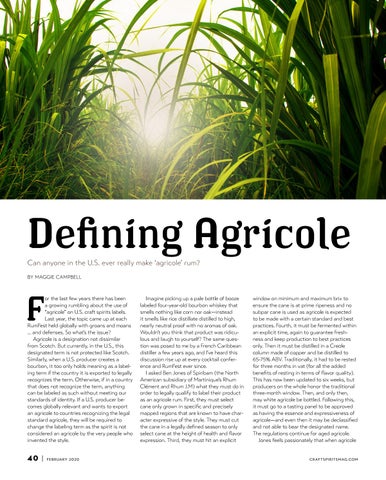Defining Agricole Can anyone in the U.S. ever really make ‘agricole’ rum? BY MAGGIE CAMPBELL
F
or the last few years there has been a growing rumbling about the use of “agricole” on U.S. craft spirits labels. Last year, the topic came up at each RumFest held globally with groans and moans … and defenses. So what’s the issue? Agricole is a designation not dissimilar from Scotch. But currently, in the U.S., this designated term is not protected like Scotch. Similarly, when a U.S. producer creates a bourbon, it too only holds meaning as a labeling term if the country it is exported to legally recognizes the term. Otherwise, if in a country that does not recognize the term, anything can be labeled as such without meeting our standards of identity. If a U.S. producer becomes globally relevant and wants to export an agricole to countries recognizing the legal standard agricole, they will be required to change the labeling term as the spirit is not considered an agricole by the very people who invented the style.
40 |
F EBRUARY 2020
Imagine picking up a pale bottle of booze labeled four-year-old bourbon whiskey that smells nothing like corn nor oak—instead it smells like rice distillate distilled to high, nearly neutral proof with no aromas of oak. Wouldn’t you think that product was ridiculous and laugh to yourself? The same question was posed to me by a French Caribbean distiller a few years ago, and I’ve heard this discussion rise up at every cocktail conference and RumFest ever since. I asked Ben Jones of Spiribam (the North American subsidiary of Martinique’s Rhum Clément and Rhum J.M) what they must do in order to legally qualify to label their product as an agricole rum. First, they must select cane only grown in specific and precisely mapped regions that are known to have character expressive of the style. They must cut the cane in a legally defined season to only select cane at the height of health and flavor expression. Third, they must hit an explicit
window on minimum and maximum brix to ensure the cane is at prime ripeness and no subpar cane is used as agricole is expected to be made with a certain standard and best practices. Fourth, it must be fermented within an explicit time, again to guarantee freshness and keep production to best practices only. Then it must be distilled in a Creole column made of copper and be distilled to 65-75% ABV. Traditionally, it had to be rested for three months in vat (for all the added benefits of resting in terms of flavor quality). This has now been updated to six weeks, but producers on the whole honor the traditional three-month window. Then, and only then, may white agricole be bottled. Following this, it must go to a tasting panel to be approved as having the essence and expressiveness of agricole—and even then it may be declassified and not able to bear the designated name. The regulations continue for aged agricole. Jones feels passionately that when agricole
C R AF T S PI R I T S MAG .CO M
